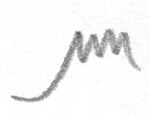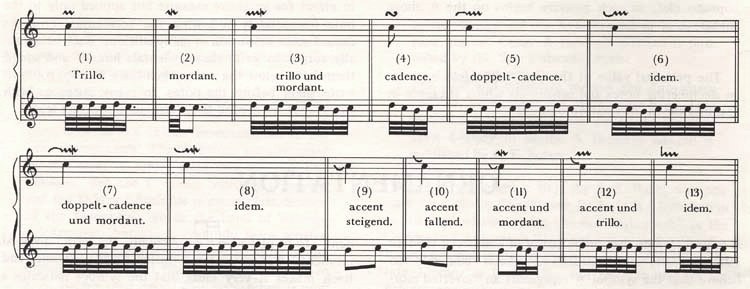Ornament (music)
In the baroque period, it was common for performers to improvise ornamentation on a given melodic line. A singer performing a da capo aria, for instance, would sing the melody relatively unornamented the first time, but decorate it with additional flourishes the second time. Improvised ornamentation continues to be part of the Irish musical tradition,[2] particularly in sean-nós singing but also throughout the wider tradition as performed by the best players.
Ornamentation may also be indicated by the composer. A number of standard ornaments (described below) are indicated with standard symbols in music notation, while other ornamentations may be appended to the staff in small notes, or simply written out normally. Frequently, a composer will have his or her own vocabulary of ornaments, which will be explained in a preface, much like a code. A grace note is a note written in smaller type, with or without a slash through it, to indicate that its note value does not count as part of the total time value of the measure. Alternatively, the term may refer more generally to any of the small notes used to mark some other ornament (see Appoggiatura, below), or in association with some other ornament’s indication (see Trill, below), regardless of the timing used in the execution.
In Spain, melodies ornamented upon repetition ("divisions") were called "diferencias", and can be traced back to 1538, when Luis de Narváez published the first collection of such music for the vihuela.[3]
Western classical music
Trill
Main article: Trill (music)
A trill is a rapid alternation between an indicated note and the one above, also known as the shake.
Usually, if the music containing the trill was written before 1800 the
trill is played by starting a note above the written note. If the music
was written after 1800 then the trill is usually played by starting on
the note written and going up to the note above. A printed score will
often indicate which interpretation is to be used, either in the preface
to the score or by using a grace note.Sometimes it is expected that the trill will end with a turn (by sounding the note below rather than the note above the principal note, immediately before the last sounding of the principal note), or some other variation. Such variations are often marked with a few grace notes following the note that bears the trill indication. The trill is indicated by either a
 or a
or a  ~~, with the ~ representing the length of the trill, above the staff. In Baroque music, the trill is sometimes indicated with a + (plus) sign above or below the note.
~~, with the ~ representing the length of the trill, above the staff. In Baroque music, the trill is sometimes indicated with a + (plus) sign above or below the note.
There is also a single tone trill variously called trillo or tremolo in late Renaissance and early Baroque.
Mordent
Main article: Mordent
The mordent is thought of as a rapid alternation between an indicated note, the note above (called the upper mordent, inverted mordent, or pralltriller) or below (called the lower mordent or mordent), and the indicated note again.The upper mordent is indicated by a short squiggle (which may also indicate a trill); the lower mordent is the same with a short vertical line through it:

As with the trill, the exact speed with which the mordent is performed will vary according to the tempo of the piece, but, at a moderate tempo, the above might be executed as follows:

In the Baroque period, a Mordant (the German or Scottish equivalent of mordent) was what later came to be called an inverted mordent and what is now often called a lower mordent. In the 19th century, however, the name mordent was generally applied to what is now called the upper mordent. Although mordents are now thought of as just a single alternation between notes, in the Baroque period a Mordant may sometimes have been executed with more than one alternation between the indicated note and the note below, making it a sort of inverted trill. Mordents of all sorts might typically, in some periods, begin with an extra inessential note (the lesser, added note), rather than with the principal note as shown in the examples here. The same applies to trills, which in Baroque and Classical times would standardly begin with the added, upper note. A lower inessential note may or may not be chromatically raised (that is, with a natural, a sharp, or even a double sharp) to make it just one semitone lower than the principal note.
Turn
"Gruppetto" redirects here. For the group of cyclists behind the peloton, see Grupetto.
A turn is a short figure consisting of the note above the one
indicated, the note itself, the note below the one indicated, and the
note itself again. It is marked by a mirrored S-shape lying on its side
above the staff.The details of its execution depend partly on the exact placement of the turn mark. The following turns:

might be executed like this:

The exact speed at which the notes of a turn are executed can vary, as can its rhythm. The question of how a turn is best executed is largely one of context, convention, and taste. The lower and upper added notes may or may not be chromatically raised (see mordent).
An inverted turn (the note below the one indicated, the note itself, the note above it, and the note itself again) is usually indicated by putting a short vertical line through the normal turn sign, though sometimes the sign itself is turned upside down.
Appoggiatura
- See also Nonchord tone#Appoggiatura.
The appoggiatura is written as a grace note prefixed to a principal note and printed in small character, usually without the oblique stroke:

This may be executed as follows:

As psychologist Dr. John Sloboda reported around 1992, the appoggiatura is found in many songs which elicit very specific emotional responses in listeners, such as tears and goosebumps.[1] Something thought to be similar to appoggiaturas and a slight modulation of pitch "at the end of long notes right before the accompaniment goes to a new harmony" during the chorus have been credited with much of the effect that Adele's "Someone Like You", for example, has on its audience.[1]
An ascending appoggiatura was previously known as a forefall, while a descending appoggiatura was known as a backfall.
Acciaccatura
Acciaccatura (/əˌtʃækəˈtjʊərə/, Italian: [attʃakkaˈtuːra]) comes from the Italian verb acciaccare, "to crush". The acciaccatura (sometimes called short appoggiatura) is perhaps best thought of as a shorter, less melodically significant, variant of the long appoggiatura, where the delay of the principal note is scarcely perceptible – theoretically subtracting no time at all. It is written using a grace note (often a quaver, or eighth note), with an oblique stroke through the stem:
The exact interpretation of this will vary according to the tempo of the piece, but the following is possible:

Whether the note should be played before or on the beat is largely a question of taste and performance practice. Exceptionally, the acciaccatura may be notated in the bar preceding the note to which it is attached, showing that it is to be played before the beat. (This guide to practice is unfortunately not available, of course, if the principal note does not fall at the beginning of the measure.)
The implication also varies with the composer and the period. For example, Mozart’s and Haydn’s long appoggiaturas are – to the eye – indistinguishable from Mussorgsky’s and Prokofiev’s before-the-beat acciaccaturas. In some cases on instruments that permit it, such as the piano, the acciaccatura is sounded simultaneously with the principal note, and then immediately released.
Glissando
Main article: Glissando
A glissando is a slide from one note to another, signified by a wavy
line connecting the two notes. All of the intervening diatonic or
chromatic (depending on instrument and context) are heard, albeit very
briefly. In this way, the glissando differs from portamento.In contemporary classical music (especially in avant garde pieces) a glissando tends to assume the whole value of the initial note.
Schleifer
Main article: Slide (musical ornament)
A slide (Schleifer in German) instructs the performer to begin
one or two scale steps below the marked note and slide upward. The
schleifer usually includes a prall trill or mordent trill at the end.Willard A. Palmer wrote, "The schleifer is a "sliding" ornament, usually used to fill in the gap between a note and the previous one."[4]





Tidak ada komentar:
Posting Komentar